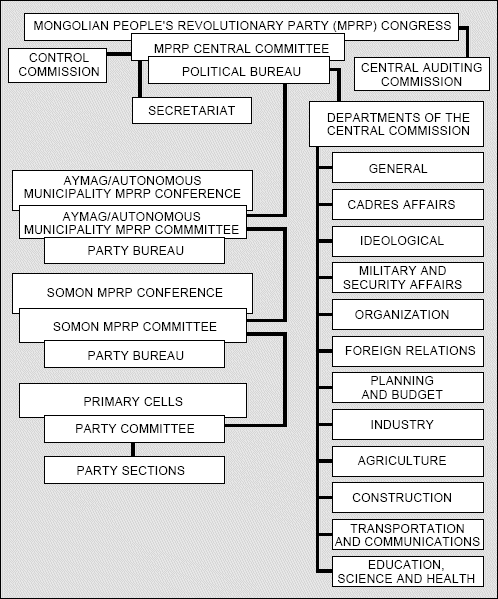| This Web book is based on public domain material provided by the US government and is available in several versions. See the editorial for more information. |

|

Home  Government and Politics Government and Politics  Mongolian People's Revolutionary Party Mongolian People's Revolutionary Party  Mongolian People's Revolutionary Party Mongolian People's Revolutionary Party |
|||
| See also: General Political Values and Attitudes, The Political Process, Other Mass Organizations, Major State Organizations, Membership, Regional and Local Party Organizations, Revolutionary Transformation, 1921-24, Consolidation of the Mongolian People's Republic, 1925- 28, Purges of the Opposition, 1928-32 | |||






|
|||
Mongolian People's Revolutionary Party
Mongolia's communist party was established on March 1, 1921, with 164 members in a country that previously had no political parties. At that time, it was called the Mongolian People's Party (see Revolutionary Transformation, 1921-24). In August 1924 at the Third Party Congress, the party assumed its current nomenclature, the Mongolian People's Revolutionary Party. It was the only political party, modeled closely after the organizational structure and party program of the Communist Party of the Soviet Union. It has followed the Soviet example during most of its existence, and it continued to do so in mid-1989. The authoritative Party Program, the fourth in Mongolian history, which was adopted in 1966, states that party organizations serve as "the directing and guiding force of society and the state," and at the national level are decisive in setting policy, developing programs, and making key personnel appointments. Below the national level, party organizations and personnel ensure the implementation of the Party Program, maintain political discipline, and supervise appointment to all party and non-party organizations. Following the pattern of ongoing developments in the Soviet Union, high-level substantive discussions of party organizational reform measures were being held in 1989. One measure under consideration would have government bodies play an enhanced role as consultative bodies in the party's policy-making process. New senior government bodies that eventually could disperse some of the party's closely held power were being discussed. Consideration also was being given to the devolution of some decision-making powers from upper party levels to the primary party organizations. Nevertheless, in the late 1980s, top-level party organizations still continued to hold exceptional authority, dominating the governmental, economic, and military life of the country.
|
|||
Home  Government and Politics Government and Politics  Mongolian People's Revolutionary Party Mongolian People's Revolutionary Party  Mongolian People's Revolutionary Party Mongolian People's Revolutionary Party |
|||
Last Update: 2010-12-07


